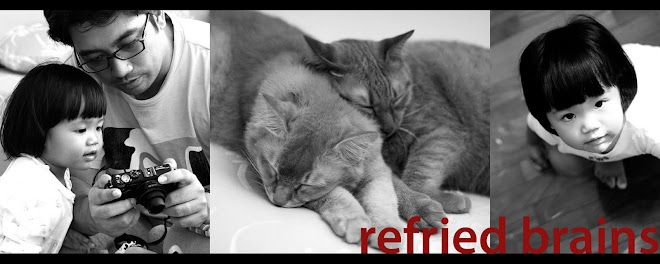Previously, mention of Navarathri would bring to mind sis' Odissi performance at Sutra, which according to her, are now not being performed due to complaints from neighbours. Goes to show that even though you may have a nice setting and stage built into your bungalow compound, the neighbours may still call you out on making a racket. It's a pity. I like that stage. And the setting.
 |
| The hosts: Bhagarv and Bela |
So last Saturday, we were invited to a Gujerati celebration of Navarathri at the Singapore Swimming Club. Of course, first question I asked hubby was, "Do I wear my saree?" And of course, he replied no. But he had his Punjabi top and we were off.
Right, when we got there I was probably the only one not in traditional garb. Sarees all over the place except for me. Man, did I ever feel underdressed. Score one for hubby. And we were probably the only non-Indians around (although technically, I was probably the only non-Indian around as hubby has Indian blood somewhere along his bloodline).
No matter, we were there to join in the festivities. And boy, were there festivities. The function hall was a mass of bodies. The music was blasting and the bass was pounding. And there was colour everywhere. A shrine to the Goddess Durga was placed in a corner of the room and everyone was on the floor, dancing the Dandiya-Raas.
In Gujerat, Navarathri is celebrated by dancing the Garba and the Dandiya-Raas. Garba is performed in a circle as a symbol of the Hindu view of time. The rings of dancers revolve in cycles. The dance symbolizes that God, represented in feminine form in this case, is the only thing that remains unchanging in a constantly changing universe (jagat). In Dandiya Raas men and women dance in two circles, with sticks in their hands. "Dandiya" or sticks, are about 18" long. Each dancer holds two sticks. Generally, in a four beat rhythm, opposite sides hit the sticks at the same time. One circle goes clockwise and another counter clockwise.
We got to try our hands at the Dandiya-Raas. It's not as easy as it sounds; there's a pattern and sequence to the four beat rhythm. I managed not to get my fingers bruised but I think I may have bruised some fingers myself.
 |
| Sticking out like a sore thumb |
And then of course, after the dancing, there's the ubiquitous line for food. Our hosts, Bhagarv and Bela took care of that and we had some vegetarian Indian burgers (there's a name for that but I can't remember) and authentic Indian tea.
We left around 10:30pm but the dancing actually lasts till 3am. The Gujeratis sure know how to enjoy their Navarathri. And put on an awesome party.












3 comments:
Aiyaaaaaaa!!!! Should've worn your saree!!! Everyone's so colorfully dressed!
Get yourself a nice set of Punjabi suit known as salwar kameez. It's very comfortable, much more comfortable than sari and very beautiful.
Hey :) I dropped in from Ai Ling's blog. The Indian Vegetarian Burger that you ate is called the 'Wada Paav'...'Wada' being the pattie (spiced potato filling in gram-flour covering) and the 'Paav' is the bread. It is so interesting to read about an Indian festival celebration from the perspective of a non-Indian...very nice.
Post a Comment